Constraints from Geochemistry of Mineralization-Hosting Sandstone and Sulfur Isotopes of Pyrite on Uranium Mineralization in the Liuhuanggou Area, Southern Junggar Basin
Abstract
1. Introduction
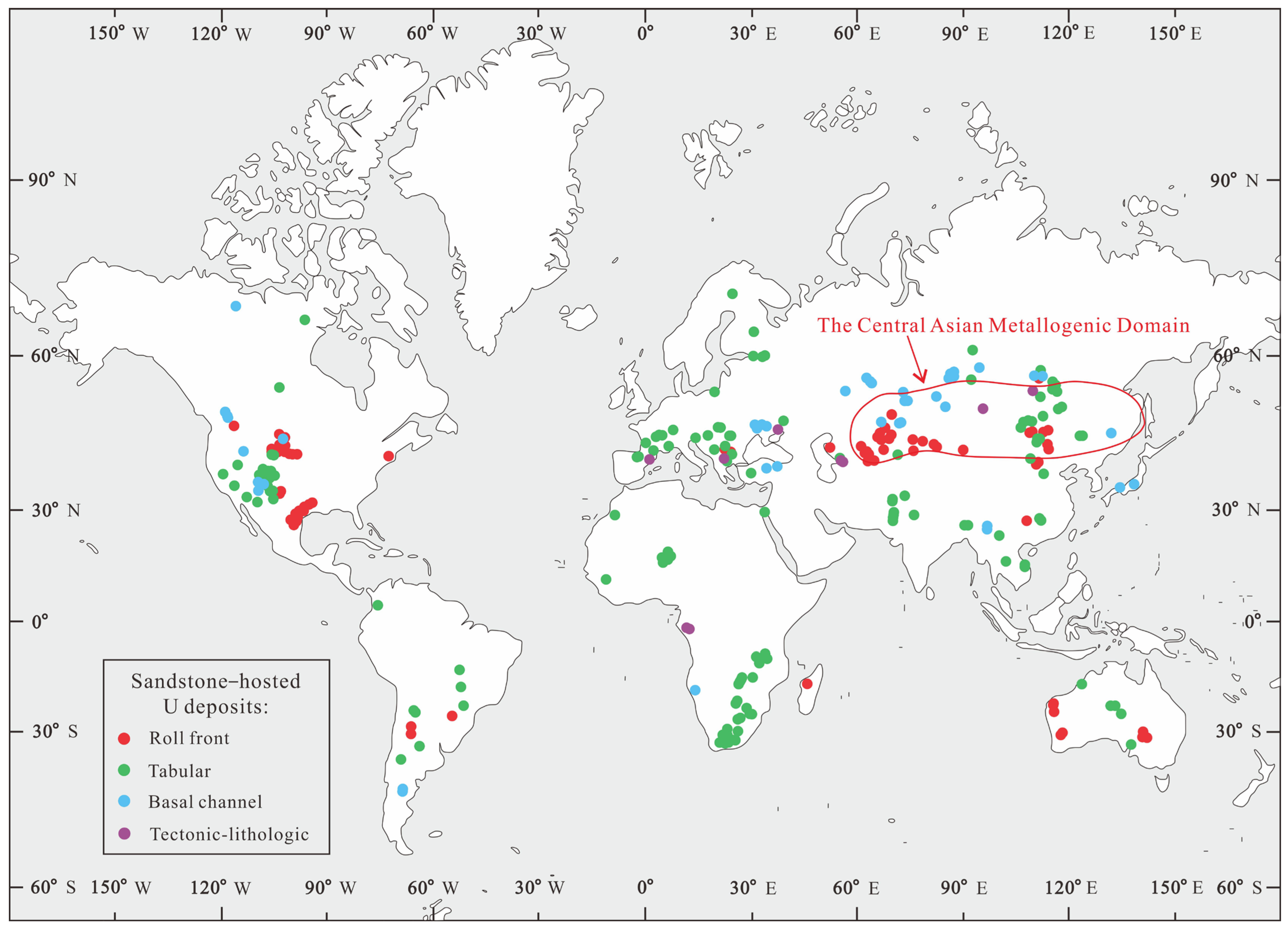
2. Geological Setting
2.1. Regional Geology
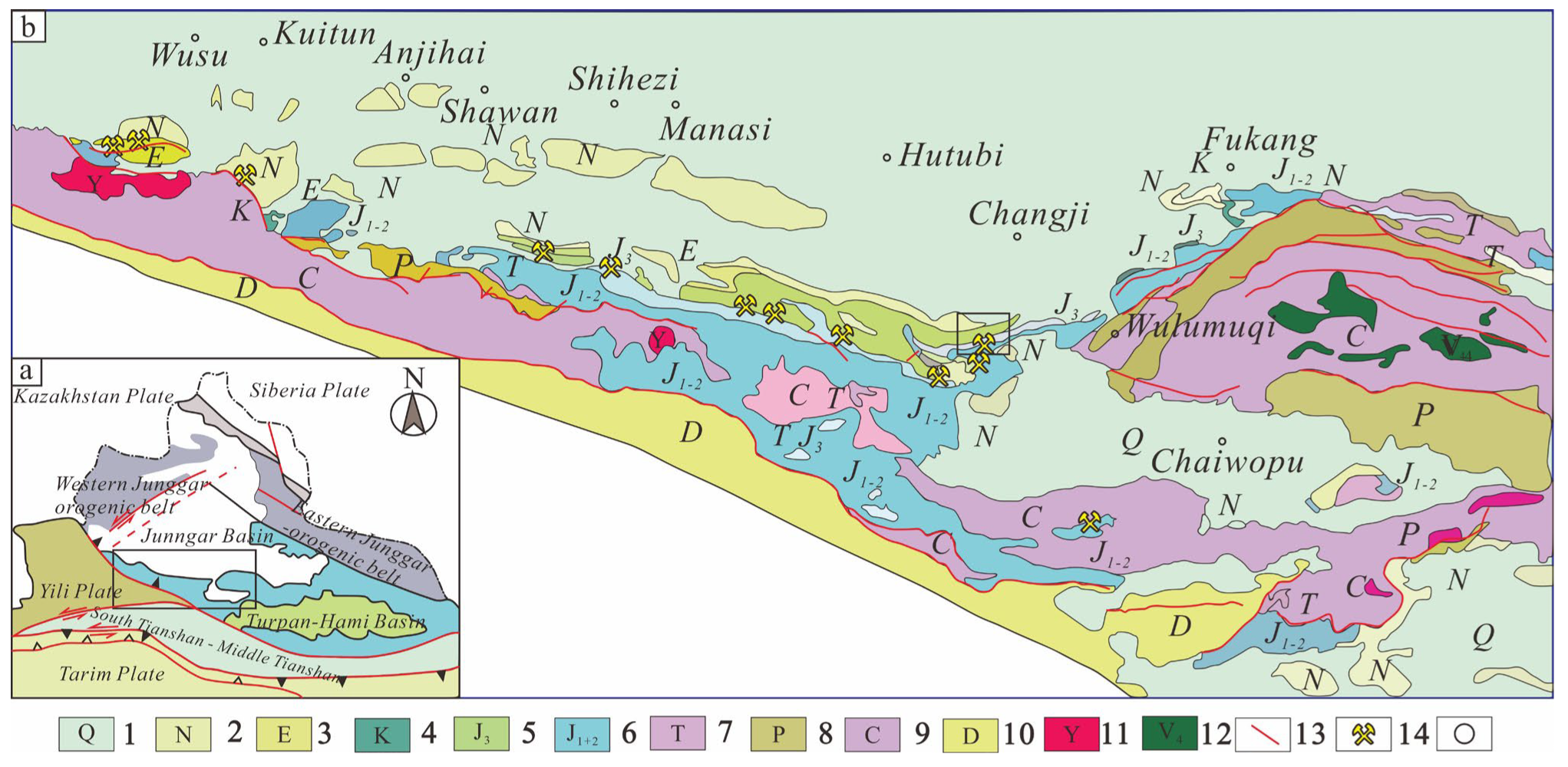
2.2. Deposit Geology
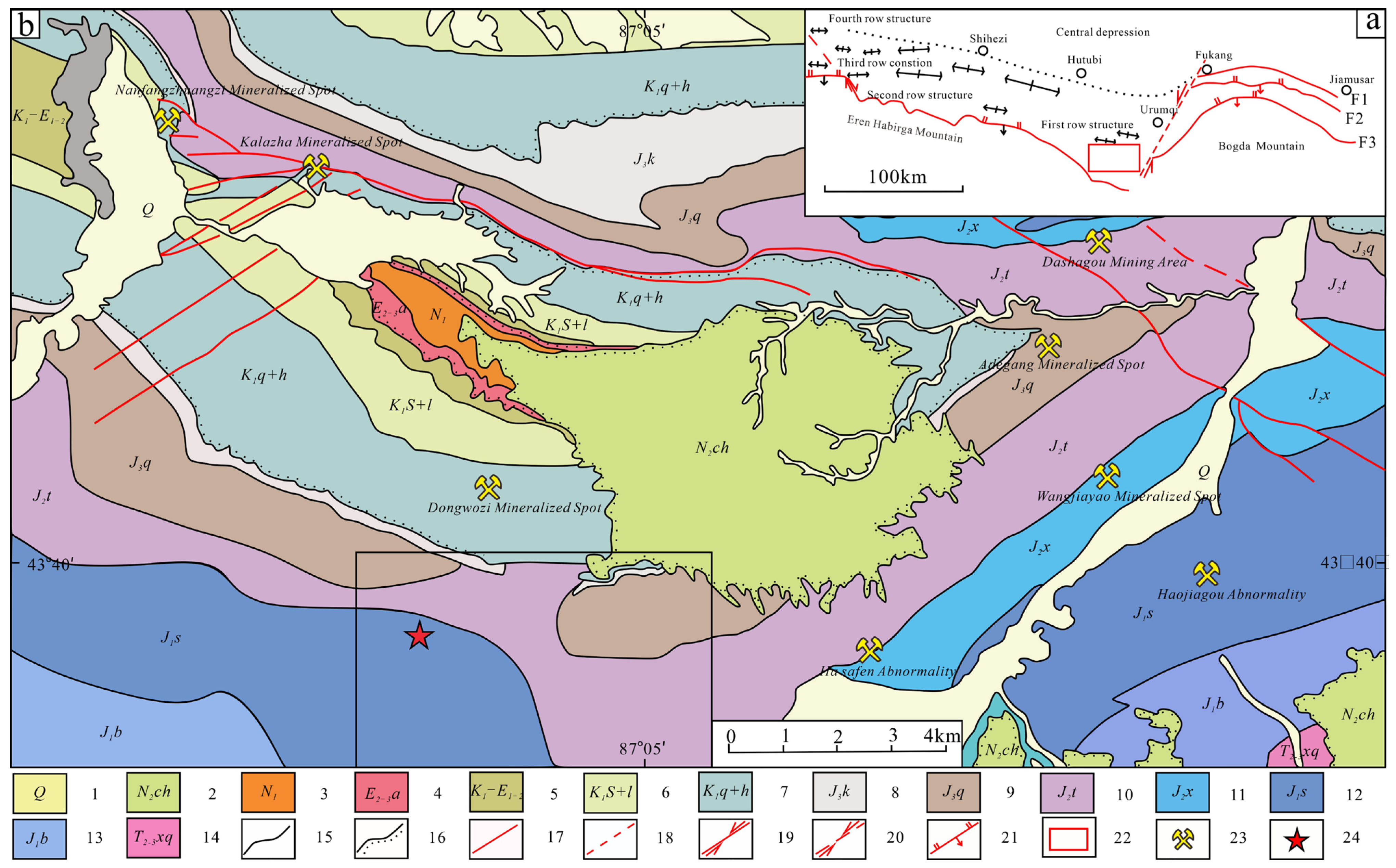
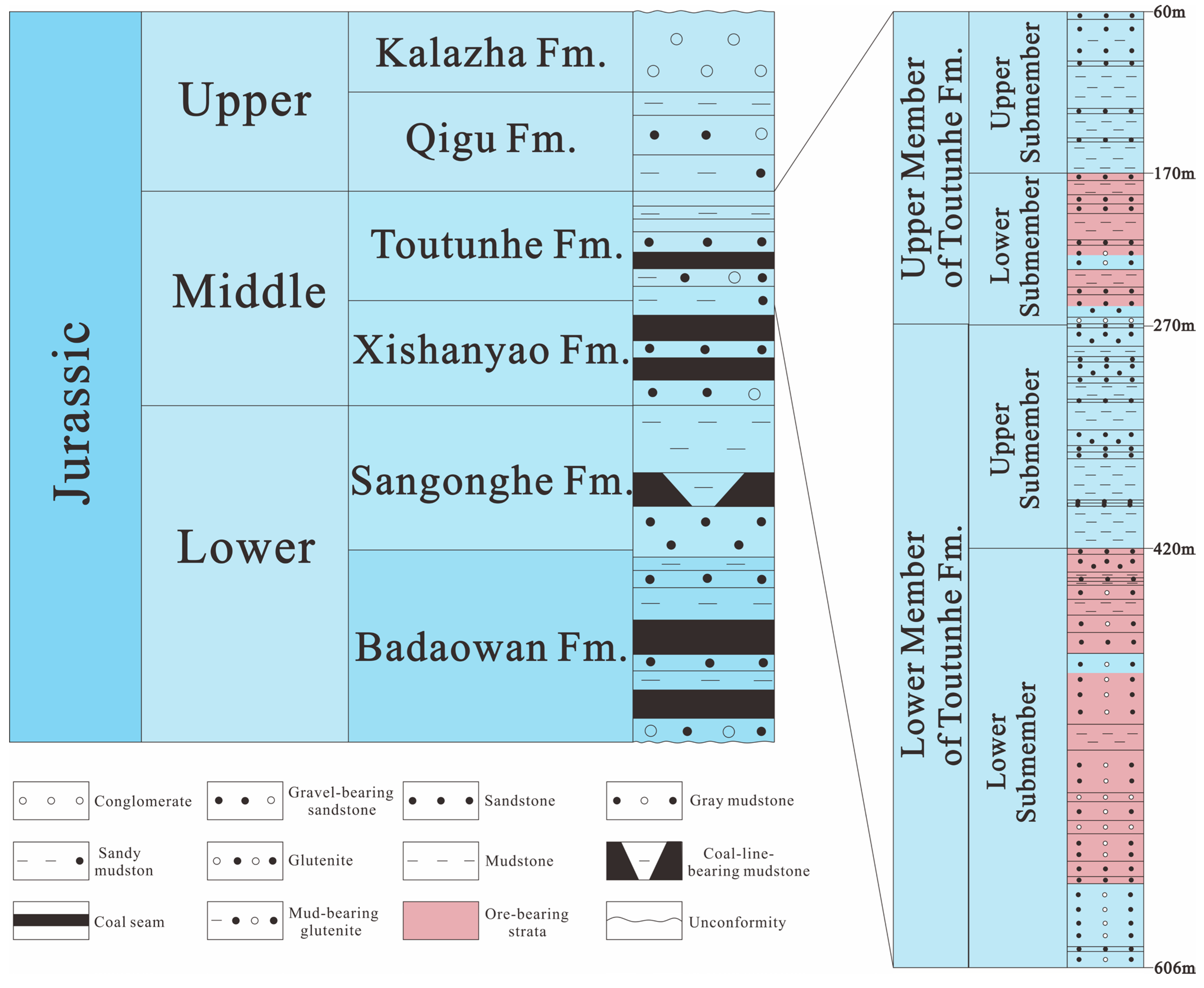
3. Analytical Methods
3.1. Scanning Electron Microscope
3.2. Whole-Rock Major and Trace Element Analysis
3.3. In Situ Sulfur Isotope Analysis of Pyrite
3.4. Microspectrofluorometric Analysis of Fluid Inclusions
4. Results
4.1. Major Elements
4.2. Trace Elements
4.3. Pyrite Micromorphologies
4.4. Sulfur Isotopes
4.5. Microspectrofluorometric Analysis of Fluid Inclusions
5. Discussion
5.1. Provenance Terrains of Mineralized Sandstone
5.2. Sulfur Sources and Pyrite Genesis
5.3. Genesis of the Deposit
6. Conclusions
Author Contributions
Funding
Data Availability Statement
Acknowledgments
Conflicts of Interest
References
- Bonnetti, C.; Cuney, M.; Michels, R.; Truche, L.; Malartre, F.; Liu, X.; Yang, J. The multiple roles of sulfate-reducing bacteria and Fe-Ti oxides in the genesis of the Bayinwula roll front-type uranium deposit, Erlian Basin, NE China. Econ. Geol. 2015, 110, 1059–1081. [Google Scholar] [CrossRef]
- Reynolds, R.L.; Goldhaber, M.B.; Carpenter, D.J. Biogenic and nonbiogenic ore-forming processes in the south Texas uranium district: Evidence from the Panna Maria deposit. Econ. Geol. 1982, 77, 541–556. [Google Scholar] [CrossRef]
- Cuney, M. The extreme diversity of uranium deposits. Miner. Depos. 2009, 44, 3–9. [Google Scholar] [CrossRef]
- Cumberland, S.A.; Douglas, G.; Grice, K.; Moreau, J.W. Uranium mobility in organic material-rich sediments: A review of geological and geochemical processes. Earth-Sci. Rev. 2016, 159, 160–185. [Google Scholar] [CrossRef]
- Bhattacharyya, A.; Campbell, K.M.; Kelly, S.D.; Roebbert, Y.; Weyer, S.; Bernier Latmani, R.; Borch, T. Biogenic non-crystalline U (IV) revealed as major component in uranium ore deposits. Nat. Commun. 2017, 8, 15538. [Google Scholar] [CrossRef]
- Hazen, R.M.; Ewing, R.C.; Sverjensky, D.A. Evolution of uranium and thorium minerals. Am. Miner. 2009, 94, 1293–1311. [Google Scholar] [CrossRef]
- Jiao, Y.Q.; Wu, L.Q.; Peng, Y.B.; Rong, H.; Ji, D.M.; Miao, A.S.; Li, H.L. Sedimentary-tectonic setting of the deposition-type uranium deposits forming in the Paleo-Asian tectonic domain, North China. Earth Sci. Front. 2015, 22, 189–205. [Google Scholar]
- Cuney, M. Evolution of uranium fractionation processes through time: The secular variation of uranium deposit types. Econ. Geol. 2010, 105, 553–569. [Google Scholar] [CrossRef]
- Fayek, M.; Horita, J.; Ripley, E.M. The oxygen isotopic composition of uranium minerals: A review. Ore Geol. Rev. 2011, 41, 1–21. [Google Scholar] [CrossRef]
- Granger, H.C.; Warren, C.G. Unstable sulfur compounds and the origin of roll-type uranium deposits. Econ. Geol. 1969, 64, 160–171. [Google Scholar] [CrossRef]
- Warren, C.G. A method for discriminating between biogenic and chemical origins of the ore-stage pyrite in a roll-type uranium deposit. Econ. Geol. 1971, 66, 919–928. [Google Scholar] [CrossRef]
- Rackley, R.I. Environment of Wyoming Tertiary uranium deposits. Am. Assoc. Pet. Geol. Bull. 1972, 56, 755–774. [Google Scholar]
- Dahlkamp, F.J. Uranium Deposits of the World: Asia; Springer: Berlin/Heidelberg, Germany, 2009; pp. 21–24. [Google Scholar]
- Hall, S.M.; Mihalasky, M.J.; Tureck, K.R.; Hammarstrom, J.M.; Hannon, M.T. Genetic and grade and tonnage models for sandstone-hosted roll-type uranium deposits, Texas Coastal Plain, USA. Ore Geol. Rev. 2017, 80, 716–753. [Google Scholar] [CrossRef]
- Geng, Y.Y.; Liu, Z.Y.; Huang, S.H. Ore -forming environment and direction of mineralization of sandstone uranium ore in the Toutunhe Area, Southern margin of Junggar Basin. Uranium Geol. 2022, 38, 194–206. [Google Scholar]
- Bonnetti, C.; Zhou, L.; Riegler, T.; Brugger, J.; Fairclough, M. Large S isotope and trace element fractionations in pyrite of uranium roll front systems result from internally-driven biogeochemical cycle. Geochim. Et Cosmochim. Acta 2020, 282, 113–132. [Google Scholar] [CrossRef]
- Hough, G.; Swapp, S.; Frost, C.; Fayek, M. Sulfur isotopes in biogenically and abiogenically derived uranium roll-front deposits. Econ. Geol. 2019, 114, 353–373. [Google Scholar] [CrossRef]
- Barrie, C.D.; Boyce, A.J.; Boyle, A.P.; Williams, P.J.; Blake, K.; Ogawara, T.; Akai, J.; Prior, D.J. Growth controls in colloform pyrite. Am. Miner. 2009, 94, 415–429. [Google Scholar] [CrossRef]
- Rong, H.; Jiao, Y.Q.; Wu, L.Q.; Ji, D.M.; Li, H.L.; Zhu, Q.; Cao, M.Q.; Wang, X.M.; Li, Q.C.; Xie, H.L. Epigenetic alteration and its constraints on uranium mineralization from the Qianjiadian uranium deposit, southern Songliao Basin. Earth Sci. 2016, 41, 153–166. [Google Scholar]
- Wei, H.Y.; Wei, X.M.; Qiu, Z.; Song, H.Y.; Guo, S. Redox conditions across the G-L boundary in South China: Evidence from pyrite morphology and sulfur isotopic compositions. Chem. Geol. 2016, 440, 1–14. [Google Scholar] [CrossRef]
- Mahoney, C.; März, C.; Buckman, J.; Wagner, T.; Blanco-Velandia, V.O. Pyrite oxidation in shales: Implications for palaeo-redox proxies based on geochemical and SEM-EDX evidence. Sediment. Geol. 2019, 389, 186–199. [Google Scholar] [CrossRef]
- Jiao, Y.Q.; Wu, L.Q.; Rong, H.; Zhang, F.; Tao, Z.P.; Yue, L. Geological Modeling for Uranium Reservoir Heterogeneity: A Sedimentology Basis for Revealing Uranium Metallogenic Mechanism and Enhancing Uranium Recovery in Zhiluo Formation in Ordos Basin; Wang, F.L., Ed.; China University of Geosciences Press: Wuhan, China, 2021; pp. 106–113. [Google Scholar]
- IAEA. World Distribution of Uranium Provinces; International Atomic Energy Agency: Vienna, Austria, 2021. [Google Scholar]
- Ren, J.Q.; Huang, J.Q. Geotectonics and evolution in China. Sci. Press Rev. 1980, 32, 262–274. [Google Scholar]
- Li, J.Y.; Xiao, X.C.; Tang, Y.Q. Basic features of Late paleozoic plate Tectonics in the Karameri Region of East Junggar. Geol. Rev. 1990, 36, 305–316. [Google Scholar]
- Song, J.Y.; Qin, M.K.; Cai, X.Q. Basement structural characteristics of Junggar Basin and its influence on sandstone type uranium ore mineralization. Geol. Rev. 2015, 61, 128–138. [Google Scholar]
- Zhou, T.Q.; Wu, C.D.; Yu, B. New insights into multiple provebances evolution of the Jurassic from heavy minerals characteristics in southern Junggar Basin, NW CHINA. Pet. Explor. Dev. 2019, 46, 65–78. [Google Scholar] [CrossRef]
- Yao, C.; Guo, W.; Liu, J.; Li, H. Xinjiang Uygur Autonomous Region Bureau of Geology and Mineral Resources. In Regional Geology of Xinjiang Uygur Autonomous Region; Geological Publishing House: Beijing, China, 1993. [Google Scholar]
- Yan, J.J.; Jia, W.W.; Huang, S. Relationship between Middle-Cenozoic Tectonic evolution and Jurassic uranium mineralization in the Sulphur Gorge Area, southern margin of Junggar Basin. Uranium Geol. 2022, 38, 1022–1031. [Google Scholar]
- Chen, Z.L.; Lu, K.G.; Wang, G.; Chen, B.L.; Wang, G.R.; Zhang, E.J.; Cui, L.L.; Ding, W.J. Characteristics of cenozoic structural movements in southern margin of Junggar basin and its relationship to the mineralization of sandstone-type uranium deposits. Acta Petrol. Sin. 2010, 26, 457–470. [Google Scholar]
- He, Z.B.; Liu, Z.Y.; Yang, Y. Exploration of the relationship between tectonic-sedimentary evolution and sandstone-type uranium mineralization in the Junggar Basin during the Minddle Cenozoic. Xinjiang Geol. 2016, 34, 410–417. [Google Scholar]
- Huang, S.H.; Qin, M.K.; Liu, Z.Y. Constraints on sandstone uranium mineralization by diagenesis and hydrocarbon intrusion-example of sandstone uranium mineralization in the Toutunhe Foration, Liuhuanggou Area, Zhunan. J. Sedimentol. 2016, 34, 250–259. [Google Scholar]
- Li, Q.; Wu, B.L.; Zhou, Y. Sedimentary characteristics and uranium mineralization prospect analysis of the Toutunhe Formation in the Liuhuanggou Area of the southern margin of the Junggar Basin. J. Northwest Univ. 2023, 53, 635–654. [Google Scholar]
- Qi, L.; Jing, H. Determination of trace elements in granites by inductively coupled plasma mass spectrometry. Talanta 2000, 51, 507–513. [Google Scholar]
- Chen, L.; Chen, K.Y.; Bao, Z.A.; Liang, P.; Sun, T.T.; Yuan, H.L. Preparation of standards for in situ sulfur isotope measurement in sulfide using femtosecond laser ablation MC-ICP-MS. Java Authentication Auth. Serv. 2017, 32, 107–116. [Google Scholar] [CrossRef]
- Bao, Z.A.; Chen, L.; Zong, C.L.; Yuan, H.L.; Chen, K.Y.; Dai, M.N. Development of pressed sulfide powder tablets for in situ sulfur and lead isotope measurement using LA-MC-ICP-MS. Int. J. Mass Spectrom. 2017, 421, 255–262. [Google Scholar] [CrossRef]
- Nesbitt, H.W.; Young, G.M. Early Proteorzoi climates and Plate motion infemed from major element chemistry of lutites. Nature 1982, 299, 715–717. [Google Scholar] [CrossRef]
- Zhu, X.Y.; Wang, Y.L.; Wang, Z.C.; Zhang, C.J. Application of REE characteristics in the study of sandstone type uranium deposit: A case study of a uranium deposits in the Northern Sichuan Basin. Geol. Rev. 2005, 51, 401–408. [Google Scholar]
- Sun, S.S.; Mcdonough, W.F. Chemical and isotopic systematics of Oceanic Basalts:implications for mantle composition and processes. Geol. Soc. Lond. Spec. Publ. 1989, 42, 313–345. [Google Scholar] [CrossRef]
- Geng, Y.Y.; Liu, Z.Y.; He, Z.H.; Huang, S.H.; Guo, Q.; Xu, Q.; Song, J.Y. Provenance and ore-forming tectonic setting of sandstone-type uranium deposits in the southern margin of Junggar Basin-Insights from U-Pb ages and Hf isotopes of detrital zircons. Geol. Rev. 2020, 66, 393–409. [Google Scholar]
- Roser, B.P.; Korsch, R.J. Provenance signatures of sandstone-mudstone suites determined using discriminant function analysis of major-element date. Chem. Geol. 1988, 67, 119–139. [Google Scholar] [CrossRef]
- Ingham, E.S.; Cook, N.J.; Cliff, J.; Ciobanu, C.L.; Huddleston, A. A combined chemical, isotopic and microstructural study of pyrite from roll-front uranium deposits, Lake Eyre Basin, South Australia. Geochim. Et Cosmochim. Acta 2014, 125, 440–465. [Google Scholar] [CrossRef]
- Ohmoto, H. Systematics of sulfur and carbon isotopes in hydrothermal ore deposits. Econ. Geol. 1972, 67, 551–578. [Google Scholar] [CrossRef]
- Seal, R.R. Sulfur isotope geochemistry of sulfide minerals. Rev. Miner. Geochem. 2006, 61, 633–677. [Google Scholar] [CrossRef]
- Thode, H.G.; Monster, J.; Dunford, H.B. Sulphur isotope geochemistry. Geochim. Et Cosmochim. Acta 1961, 25, 159–174. [Google Scholar] [CrossRef]
- Kaplan, I.R.; Rittenberg, S.C. Microbiological fractionation of sulphur isotopes. J. Gen. Microbiol. 1964, 34, 195–212. [Google Scholar] [CrossRef]
- Gregory, D.D.; Kohn, M.J. Pyrite: Fool’s gold records starvation of bacteria. Am. Miner. 2020, 105, 282–283. [Google Scholar] [CrossRef]
- Yue, L.; Jiao, Y.Q.; Wu, L.Q.; Rong, H.; Xie, H.L.; Wang, Q.Y.; Yan, Q.Q. Selective crystallization and precipitation of authigenic pyrite during diagenesis in uranium reservoir sandbodies in Ordos Basin. Ore Geol. Rev. 2019, 107, 532–545. [Google Scholar] [CrossRef]
- Jensen, M. Sulfur isotopes and the origin of sandstone-type uranium deposits. Econ. Geol. 1958, 53, 598–616. [Google Scholar] [CrossRef]
- Cheney, E.S.; Jensen, M.L. Stable isotopic geology of the gas hills, Wyoming, Uranium District. Econ. Geol. 1966, 61, 44–71. [Google Scholar] [CrossRef]
- Austin, S.R. Some patterns of sulfur isotope distribution in uranium deposits. Earth Sci. Bull. 1970, 3, 243–252. [Google Scholar]
- Warren, C.G. Sulfur isotopes as a clue to the genetic geochemistry of a roll-type uranium deposit. Econ. Geol. 1972, 67, 759–767. [Google Scholar] [CrossRef]
- Goldhaber, M.B.; Reynolds, R.L.; Rye, R.O. Origin of a south Texas roll-typeuranium deposit: II. Sulfide petrology and sulfur isotope studies. Econ. Geol. 1978, 73, 1690–1705. [Google Scholar] [CrossRef]
- Reynolds, R.L.; Goldhaber, M.B. Iron disulfide minerals and the genesis of roll-type uranium deposit. Econ. Geol. 1983, 78, 105–120. [Google Scholar] [CrossRef]
- Fishman, N.S.; Reynolds, R.L. Origin of the Mariano Lake uranium deposit, McKinley County, New Mexico. AAPG Bull. 1986, A179, 211–226. [Google Scholar]
- Northrop, H.R.; Goldhaber, M.B.; Landis, G.P.; Unruh, J.W.; Reynolds, R.L.; Campbell, J.A.; Wanty, R.B.; Grauch, R.I.; Whitney, I.; Rye, R.O. Genesis of the tabular-type vanadium-uranium deposits of the Henry Basin, Utah. Econ. Geol. 1990, 85, 215–269. [Google Scholar] [CrossRef]
- Cai, C.; Li, H.; Qin, M.; Luo, X.; Wang, F.; Ou, G. Biogenic and petroleum-related oreforming processes in Dongsheng uranium deposit, NW China. Ore Geol. Rev. 2007, 32, 262–274. [Google Scholar] [CrossRef]
- Cai, C.; Dong, H.; Li, H.; Xiao, X.; Ou, G.; Zhang, C. Mineralogical and geochemical evidence for coupled bacterial uranium mineralization and hydrocarbon oxidation in the Shashagetai deposit, NW China. Chem. Geol. 2007, 236, 167–179. [Google Scholar] [CrossRef]
- Wulser, P.A.; Brugger, J.; Foden, J.; Pfeifer, H.R. The sandstone-hosted Beverley uranium deposit, Lake Frome Basin, South Australia: Mineralogy, geochemistry, and a time-constrained model for its genesis. Econ. Geolo. 2011, 106, 835–867. [Google Scholar] [CrossRef]
- Meek, A.S. Sandstone Uranium Deposits of Nebraska and Colorado: A Comparative Study. Master’s Thesis, University of Manitoba, Winnipeg, Manitoba, 2014; pp. 45–59. [Google Scholar]
- Bonnetti, C.; Liu, X.; Zhaobin, Y.; Cuney, M.; Michels, R.; Malartre, F.; Mercadier, J.; Cai, J. Coupled uranium mineralisation and bacterial sulphate reduction for the genesis of the Baxingtu sandstone-hosted U deposit, SW Songliao Basin, NE China. Ore Geol. Rev. 2017, 82, 108–129. [Google Scholar] [CrossRef]
- Lach, P.; Cathelineau, M.; Brouand, M.; Fiet, N. In-situ isotopic and chemical study of pyrite from Chu-Sarysu (Kazahkstan) roll-front uranium deposit. Procedia Earth Planet. Sci. 2015, 13, 207–210. [Google Scholar] [CrossRef]
- Liu, J.; Qiu, Y.; Zhou, J.; Wen, Z.; Fayek, M.; Zhang, H. Discussion on biogenic mineralization of sandstone-type uranium ore in Mengqiguer uranium mineral deposit. Sci. Technol. Eng. 2015, 15, 115–119. [Google Scholar]
- Chen, C.; Liu, H.J.; Hou, H.Q.; Han, S.Y.; Ke, D.; Bai, Y.S.; Ou, G.X.; Li, Y.R. The relationship between pyrite and sandstone-hosted uranium mineralization of the Zhiluo Formation in the northern Ordos Basin. Acta Geol. Sin. 2016, 90, 3375–3380. [Google Scholar]
- Pang, K. The Characteristics of In-Situ Stable Isotopes and Their Geological Significance About Sandstone Uranium Deposit in Northern Ordos Basin. Master’s Thesis, Xi’an Northwest University, Xi’an, China, 2018; pp. 39–44. [Google Scholar]
- Zhao, L.; Cai, C.; Jin, R.; Li, J.; Li, H.; Wei, J.; Guo, H.; Zhang, B. Mineralogical and geochemical evidence for biogenic and petroleum-related uranium mineralization in the Qianjiadian deposit, NE China. Ore Geol. Rev. 2018, 101, 273–292. [Google Scholar] [CrossRef]
- Chen, Y.; Jin, R.; Miao, P.; Li, J.; Guo, H.U.; Chen, L. Occurrence of pyrites in sandstone-type uranium deposits: Relationships with uranium mineralization in the North Ordos Basin, China. Ore Geol. Rev. 2019, 109, 426–447. [Google Scholar] [CrossRef]
- Ding, B.; Liu, H.X.; Zhang, B.; Li, P.; Jiang, H.; Zhang, H.J.; Xie, X.L.; Guo, C.J. Mineralogical and isotopes evidence for origin of pyrite: Implication for formation mechanism of pyrite and its relationship with uranium mineralization in Mengqigu’er uranium deposit, Yili Basin. Miner. Depos. 2019, 28, 1379–1391. [Google Scholar]
- Yi, C.; Wang, G.; Li, P.; Li, H.M.; Ding, B.; Zhang, K.; Zhang, Y. Characteristics of the ferrum phases in the Nalinggou uranium deposit, northern Ordos Basin, and its metallogenic significance. Acta Geol. Sin. 2019, 93, 470–486. [Google Scholar]
- Zhang, C.Y.; Nie, F.J.; Jiao, Y.Q.; Deng, W.; Peng, Y.B.; Hou, S.R.; Dai, M.J.; Ye, T.F. Characterization of ore-forming fluids in the Tamusu sandstone-type uranium deposit, Bayingobi Basin, China: Constraints from trace elements, fluid inclusions and C-O–S isotopes. Ore Geol. Rev. 2019, 111, 102999. [Google Scholar] [CrossRef]
- Zhang, L.; Liu, C.Y.; Lei, K.Y. Green altered sandstone related to hydrocarbon migration from the uranium deposits in the northern Ordos Basin, China. Ore Geol. Rev. 2019, 109, 482–493. [Google Scholar] [CrossRef]
- Huang, G.W.; Yu, F.C.; Pan, J.Y.; Cheng, Z.L.; Wu, D.H.; Xue, W.W.; Song, T.Z.; Li, S.P. Genesis of pyrite from the Mengqiguer uranium deposit in Ili Basin of Xinjiang and its implication for mineralization. Geol. China 2021, 48, 507–519. [Google Scholar]
- Yue, L.; Jiao, Y.Q.; Fayek, M.; Wu, L.Q.; Rong, H.; Xie, H.L. Transformation of Fe-Bearing Minerals from Dongsheng Sandstone-Type Uranium Deposit, Ordos Basin, North-Central China: Implications for Ore Genesis; American Mineralogist: Chantilly, VA, USA, 2021; Volume 107, pp. 1396–1409. [Google Scholar]
- Ishihara, S.; Sasaki, A. Sulfur isotopic ratios of the magnetite-series and ilmeniteseries granitoids of the Sierra Nevada batholith: A reconnaissance study. Geology 1989, 17, 788–791. [Google Scholar] [CrossRef]
- Tang, Y.Y.; Bi, X.W.; Fayek, M.; Hu, R.Z.; Wu, L.Y.; Zou, Z.C.; Feng, C.X.; Wang, X.S. Microscale sulfur isotopic compositions of sulfide minerals from the Jinding Zn-Pb deposit, Yunnan Province, Southwest China. Gondwana Res. 2014, 26, 594–607. [Google Scholar] [CrossRef]
- Rddad, L.; Mouguina, E.M. Sulfur and lead isotopic compositions of ore sulfides and mining economic potential of the high atlas mississippi valley-type ore province, morocco. J. Geochem. Explor. 2021, 226, 106765. [Google Scholar] [CrossRef]
- Machel, H.G.; Krouse, H.Y.; Sassen, R. Products and distinguishing criteria of bacterial and the rmochemical sulfate reduction. Appl. Geochem. 1995, 10, 373–389. [Google Scholar] [CrossRef]
- Machel, H.G.; Foght, J. Products and Depth Limits of Microbial Activity in Petroliferous Subsurface Settings. In Microbial Sediments; Riding, R., Ed.; Springer: Berlin/Heidelberg, Germany, 2000; pp. 105–120. [Google Scholar]
- Machel, H.G. Bacterial and thermochemical sulfate reduction in diagenetic settings-old and new insights. Sediment. Geol. 2001, 140, 143–175. [Google Scholar] [CrossRef]
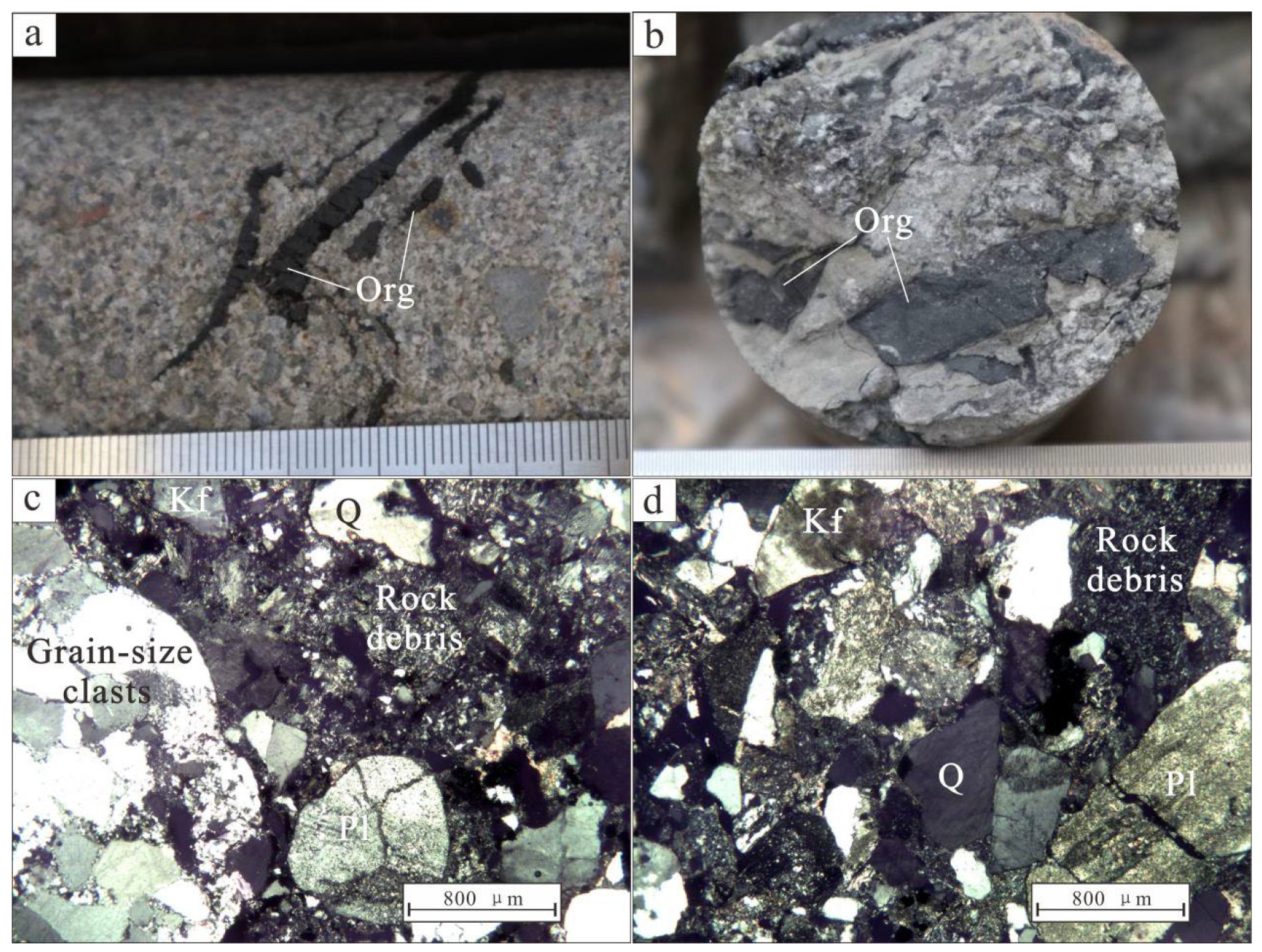


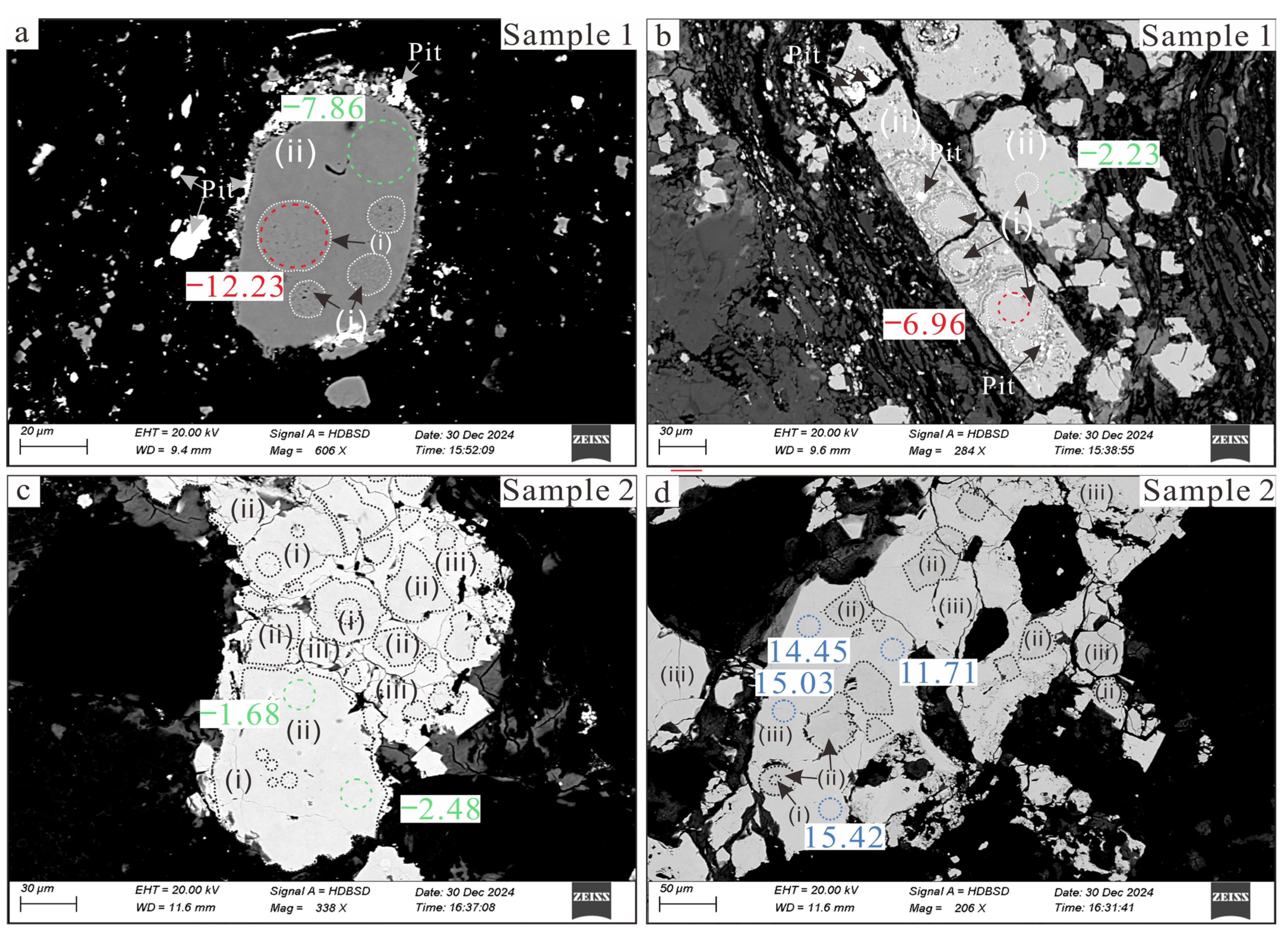
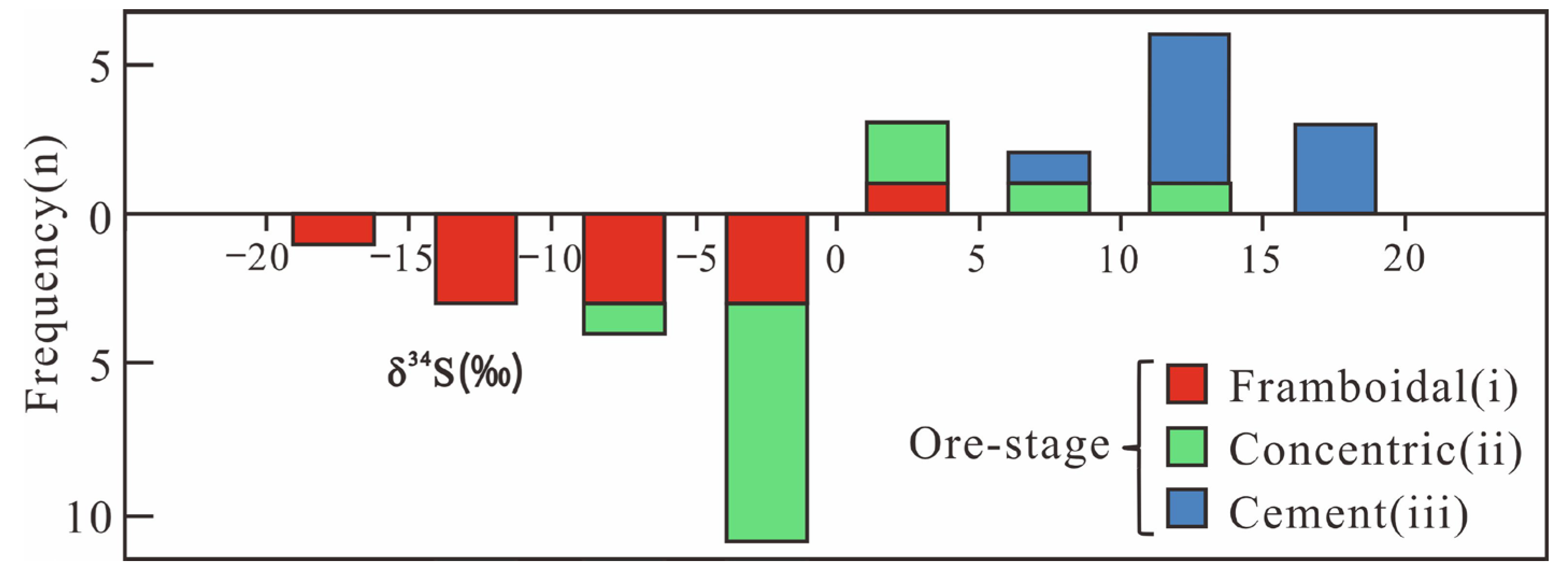

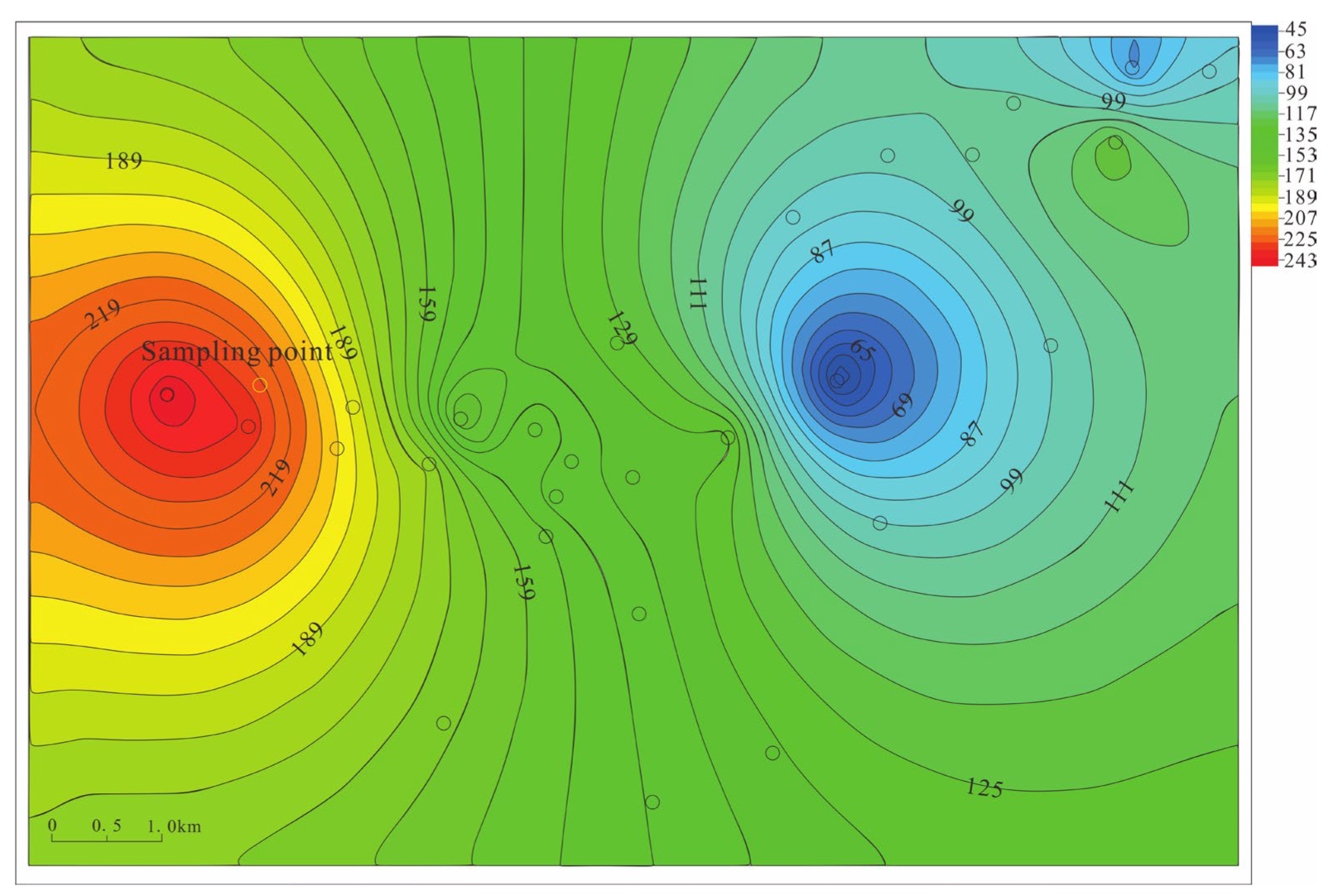

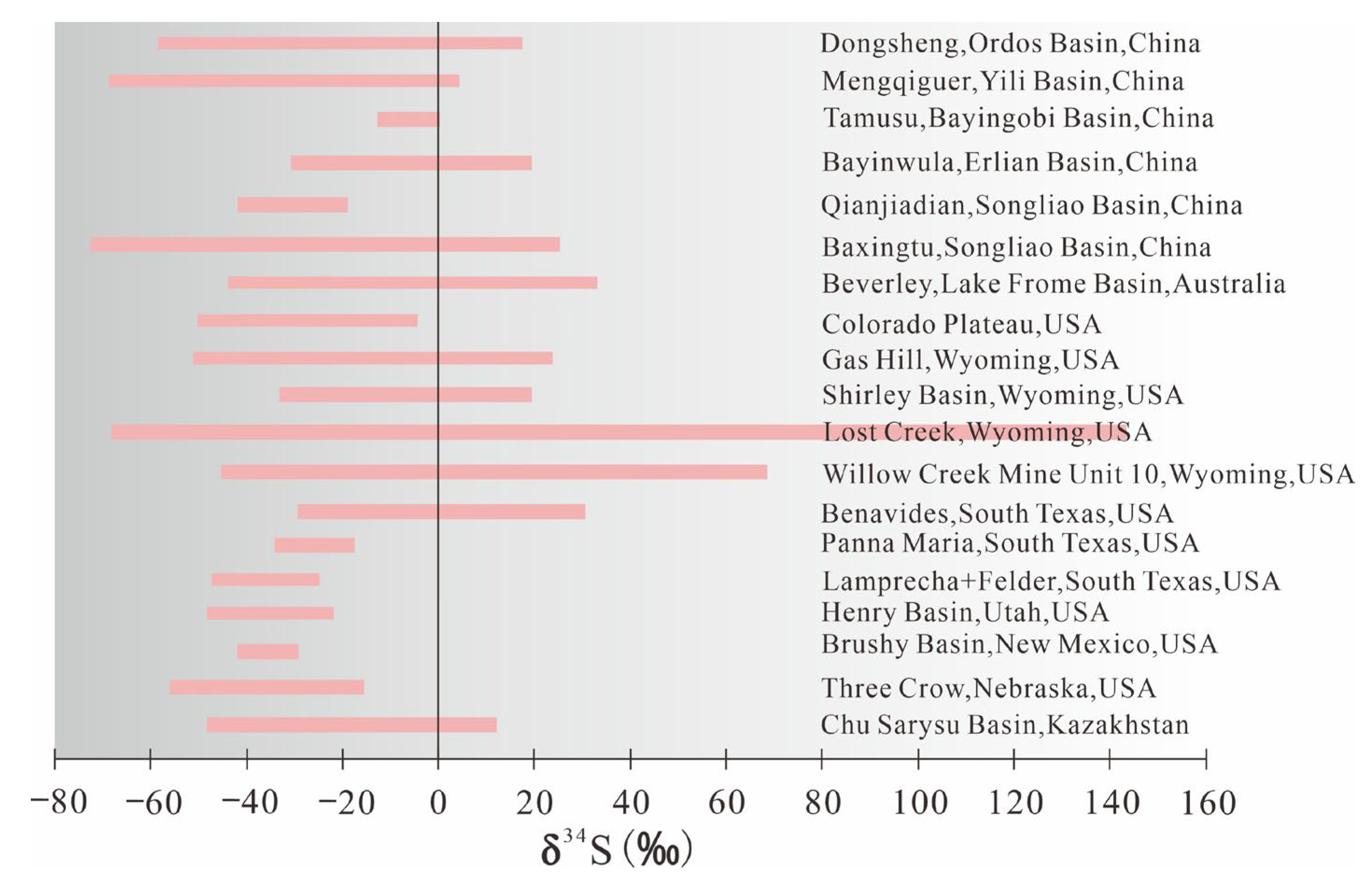
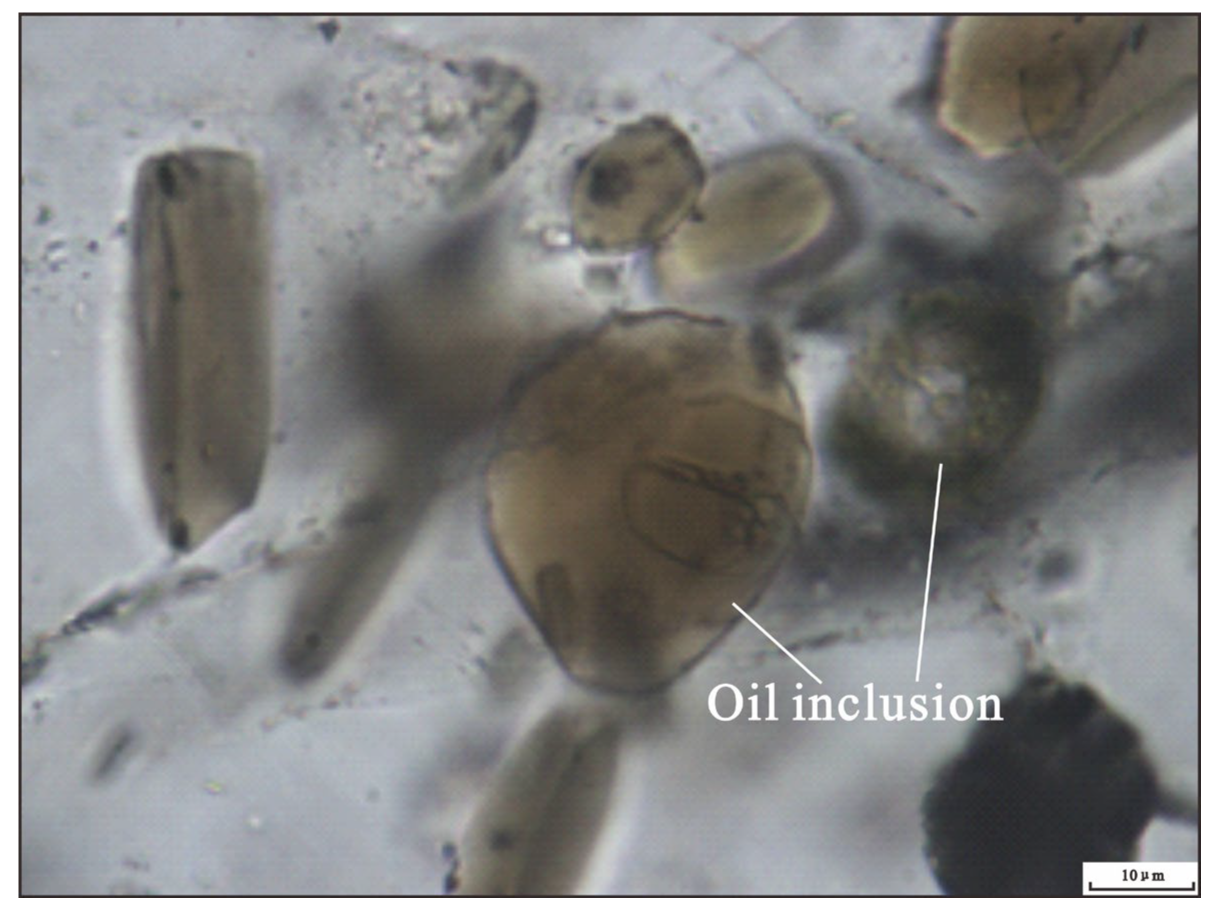


| Sample Number | Lithology | Sampling Depth/m | SiO2 | Al2O3 | TFe2O3 | MgO | CaO | Na2O | K2O | P2O5 | MnO | TiO2 | LOl | FeO | Fe2O3 | CIA |
|---|---|---|---|---|---|---|---|---|---|---|---|---|---|---|---|---|
| GSY53-6-1 | Gray pebble-bearing coarse-grained arkose | 622.03–622.23 | 79.11 | 11.14 | 1.57 | 0.02 | 0.83 | 2.58 | 3.18 | 0.05 | 0.02 | 0.20 | 2.50 | 0.59 | 0.91 | 54.78 |
| GSY53-6-2 | 642.08–642.28 | 80.03 | 11.17 | 1.37 | 0.02 | 0.54 | 2.19 | 3.09 | 0.05 | 0.02 | 0.29 | 2.03 | 0.60 | 0.70 | 58.47 | |
| GSY53-6-3 | 644.08–644.23 | 77.03 | 11.70 | 2.30 | 0.03 | 0.98 | 2.42 | 2.95 | 0.06 | 0.03 | 0.46 | 4.84 | 0.92 | 1.28 | 56.59 | |
| GSY53-6-4 | 674.08–674.28 | 75.33 | 11.26 | 1.58 | 0.09 | 4.32 | 2.72 | 3.02 | 0.05 | 0.09 | 0.30 | 4.61 | 0.67 | 0.84 | 41.87 | |
| GSY53-6-6 | 679.64–679.84 | 72.56 | 10.27 | 2.36 | 0.14 | 6.99 | 2.86 | 2.87 | 0.05 | 0.14 | 0.22 | 6.01 | 0.82 | 1.45 | 33.33 | |
| GSY53-6-7 | Gray medium- to fine-grained arkose | 691.48–691.68 | 76.14 | 11.86 | 1.81 | 0.05 | 1.93 | 2.97 | 2.83 | 0.07 | 0.05 | 0.73 | 3.18 | 0.60 | 1.14 | 50.80 |
| GSY53-6-8 | Gray pebble-bearing coar se-grained arkose | 693.48–693.68 | 78.27 | 10.99 | 1.64 | 0.04 | 1.51 | 2.97 | 3.04 | 0.06 | 0.04 | 0.31 | 2.33 | 0.60 | 0.97 | 50.10 |
| GSY53-6-9 | Gray medium- to coarse-grained arkose | 610.50–610.70 | 77.82 | 11.89 | 1.92 | 0.02 | 0.85 | 2.72 | 3.14 | 0.05 | 0.02 | 0.34 | 2.31 | 0.98 | 0.83 | 55.74 |
| Sample Number | La | Ce | Pr | Nd | Sm | Eu | Gd | Tb | Dy | Ho | Er | Tm | Yb | Lu | Y | ΣREE | LREE | HREE | LREE/HREE | δEu | δCe |
|---|---|---|---|---|---|---|---|---|---|---|---|---|---|---|---|---|---|---|---|---|---|
| GSY53-6-1 | 20.80 | 43.10 | 4.90 | 18.70 | 3.70 | 0.92 | 3.16 | 0.49 | 2.78 | 0.55 | 1.66 | 0.26 | 1.72 | 0.27 | 14.1 | 117.11 | 92.12 | 24.99 | 3.69 | 0.82 | 1.05 |
| GSY53-6-2 | 21.20 | 42.10 | 4.70 | 18.00 | 3.40 | 0.90 | 3.03 | 0.49 | 2.74 | 0.55 | 1.66 | 0.28 | 1.77 | 0.29 | 13.9 | 115.01 | 90.30 | 24.71 | 3.65 | 0.86 | 1.03 |
| GSY53-6-3 | 27.70 | 54.40 | 6.30 | 23.70 | 4.60 | 1.08 | 4.16 | 0.74 | 4.31 | 0.89 | 2.72 | 0.43 | 2.85 | 0.46 | 22.8 | 157.14 | 117.78 | 39.36 | 2.99 | 0.75 | 1.01 |
| GSY53-6-4 | 20.10 | 39.20 | 4.50 | 17.10 | 3.40 | 0.88 | 3.19 | 0.53 | 3.14 | 0.65 | 1.88 | 0.30 | 1.96 | 0.31 | 16.6 | 113.74 | 85.18 | 28.56 | 2.98 | 0.82 | 1.01 |
| GSY53-6-6 | 14.20 | 28.60 | 3.20 | 12.40 | 2.50 | 0.75 | 2.57 | 0.47 | 2.80 | 0.58 | 1.74 | 0.26 | 1.70 | 0.27 | 15.9 | 87.94 | 61.65 | 26.29 | 2.34 | 0.90 | 1.04 |
| GSY53-6-7 | 34.30 | 67.10 | 7.70 | 29.00 | 5.40 | 1.18 | 4.65 | 0.78 | 4.33 | 0.85 | 2.79 | 0.46 | 3.06 | 0.49 | 22.4 | 184.49 | 144.68 | 39.81 | 3.63 | 0.72 | 1.01 |
| GSY53-6-8 | 26.40 | 51.20 | 5.90 | 22.80 | 4.20 | 1.07 | 3.94 | 0.62 | 3.59 | 0.74 | 2.28 | 0.37 | 2.41 | 0.40 | 19.5 | 145.42 | 111.57 | 33.85 | 3.30 | 0.80 | 1.01 |
| GSY53-6-9 | 25.40 | 50.40 | 5.70 | 21.90 | 4.10 | 1.04 | 3.66 | 0.55 | 3.24 | 0.65 | 2.01 | 0.32 | 2.21 | 0.35 | 16.8 | 138.33 | 108.54 | 29.79 | 3.64 | 0.82 | 1.03 |
| Sample Number | Li | Be | Sc | V | Cr | Co | Ni | Cu | Zn | Ga | Ge | As | Rb | Sr | Zr |
| GSY53-6-1 | 6.80 | 1.18 | 3.40 | 35.7 | 14.8 | 5.53 | 9.49 | 7.56 | 14.6 | 11.4 | 1.18 | 9.12 | 91.4 | 148 | 96.4 |
| GSY53-6-2 | 5.98 | 0.96 | 3.02 | 32.8 | 13.5 | 4.19 | 7.03 | 5.68 | 15.3 | 9.60 | 1.18 | 5.83 | 77.6 | 120 | 109 |
| GSY53-6-3 | 7.46 | 1.74 | 5.38 | 75.4 | 27.5 | 10.3 | 14.7 | 11.6 | 71.5 | 12.8 | 1.27 | 24.2 | 85.1 | 155 | 238 |
| GSY53-6-4 | 5.22 | 1.12 | 4.39 | 34.6 | 15.8 | 5.34 | 7.98 | 6.97 | 9.66 | 11.1 | 1.13 | 4.99 | 87.5 | 171 | 103 |
| GSY53-6-6 | 4.14 | 1.09 | 3.93 | 38.2 | 12.4 | 6.43 | 9.13 | 14.0 | 25.2 | 9.61 | 1.13 | 18.0 | 80.9 | 402 | 88.3 |
| GSY53-6-7 | 5.61 | 1.28 | 6.83 | 51.0 | 29.2 | 6.43 | 9.39 | 8.06 | 16.6 | 12.5 | 1.11 | 4.75 | 84.9 | 163 | 319 |
| GSY53-6-8 | 5.19 | 1.12 | 4.39 | 34.1 | 16.6 | 6.97 | 9.32 | 6.71 | 22.9 | 11.4 | 1.10 | 5.97 | 88.9 | 146 | 138 |
| GSY53-6-9 | 8.27 | 1.19 | 4.92 | 43.0 | 22.2 | 7.92 | 11.5 | 7.67 | 22.3 | 12.2 | 1.11 | 5.22 | 94.7 | 130 | 150 |
| Sample Number | Nb | Mo | Cd | In | Sb | Cs | Ba | Hf | Ta | W | Tl | Pb | Bi | Th | U |
| GSY53-6-1 | 10.9 | 4.97 | 0.05 | 0.02 | 0.32 | 1.68 | 647 | 1.66 | 1.19 | 0.83 | 0.56 | 12.8 | 0.08 | 4.71 | 4.97 |
| GSY53-6-2 | 8.61 | 2.55 | 0.05 | 0.02 | 0.30 | 1.48 | 451 | 1.44 | 0.91 | 0.66 | 0.47 | 10.2 | 0.08 | 4.80 | 3.66 |
| GSY53-6-3 | 11.6 | 25.0 | 0.32 | 0.06 | 1.19 | 2.03 | 552 | 2.66 | 1.22 | 1.30 | 0.72 | 16.9 | 0.12 | 7.72 | 79.5 |
| GSY53-6-4 | 9.21 | 1.41 | 0.04 | 0.02 | 0.43 | 1.77 | 536 | 1.66 | 0.94 | 0.73 | 0.52 | 11.5 | 0.07 | 4.51 | 5.33 |
| GSY53-6-6 | 6.59 | 3.63 | 0.13 | 0.03 | 0.78 | 1.54 | 586 | 1.40 | 0.68 | 0.55 | 0.54 | 11.4 | 0.06 | 3.72 | 20.2 |
| GSY53-6-7 | 13.3 | 2.29 | 0.05 | 0.04 | 0.41 | 1.93 | 501 | 2.80 | 1.30 | 1.10 | 0.48 | 11.0 | 0.10 | 9.58 | 13.2 |
| GSY53-6-8 | 9.40 | 1.67 | 0.04 | 0.02 | 0.30 | 1.74 | 575 | 2.00 | 0.95 | 0.79 | 0.53 | 11.5 | 0.10 | 6.70 | 8.08 |
| GSY53-6-9 | 9.46 | 0.95 | 0.03 | 0.03 | 0.29 | 1.95 | 566 | 1.97 | 0.95 | 0.99 | 0.55 | 12.0 | 0.08 | 5.93 | 2.27 |
| Pyrite Types | δ34SV-CDT (‰) | 2σ |
|---|---|---|
| The framboids pyrite | −12.23 | 0.38 |
| −16.85 | 0.43 | |
| −8.65 | 0.37 | |
| −2.66 | 0.34 | |
| −11.90 | 1.35 | |
| −0.84 | 0.33 | |
| 2.16 | 0.35 | |
| −6.69 | 0.44 | |
| −3.73 | 0.22 | |
| −7.17 | 0.57 | |
| −12.93 | 0.56 | |
| The concentric overgrown pyrite | −7.86 | 0.22 |
| −0.75 | 0.37 | |
| −0.07 | 0.30 | |
| 2.88 | 0.27 | |
| 1.39 | 0.21 | |
| −0.89 | 0.49 | |
| −2.13 | 0.21 | |
| −2.67 | 0.46 | |
| −3.78 | 0.55 | |
| −1.68 | 0.24 | |
| −2.48 | 0.31 | |
| 5.11 | 0.24 | |
| 10.32 | 0.24 | |
| The sub-idiomorphic to idiomorphic cement pyrite | 14.45 | 0.15 |
| 13.62 | 0.06 | |
| 14.96 | 0.14 | |
| 16.77 | 0.20 | |
| 14.85 | 0.20 | |
| 14.43 | 0.22 | |
| 15.42 | 0.20 | |
| 15.03 | 0.11 | |
| 11.71 | 0.69 | |
| 9.16 | 0.41 |
Disclaimer/Publisher’s Note: The statements, opinions and data contained in all publications are solely those of the individual author(s) and contributor(s) and not of MDPI and/or the editor(s). MDPI and/or the editor(s) disclaim responsibility for any injury to people or property resulting from any ideas, methods, instructions or products referred to in the content. |
© 2025 by the authors. Licensee MDPI, Basel, Switzerland. This article is an open access article distributed under the terms and conditions of the Creative Commons Attribution (CC BY) license (https://creativecommons.org/licenses/by/4.0/).
Share and Cite
Li, J.; Zhou, Y.; Xue, C.; Chen, S.; Ma, G.; Yang, Z.; Liu, M.; Yang, L.; Gong, J. Constraints from Geochemistry of Mineralization-Hosting Sandstone and Sulfur Isotopes of Pyrite on Uranium Mineralization in the Liuhuanggou Area, Southern Junggar Basin. Minerals 2025, 15, 575. https://doi.org/10.3390/min15060575
Li J, Zhou Y, Xue C, Chen S, Ma G, Yang Z, Liu M, Yang L, Gong J. Constraints from Geochemistry of Mineralization-Hosting Sandstone and Sulfur Isotopes of Pyrite on Uranium Mineralization in the Liuhuanggou Area, Southern Junggar Basin. Minerals. 2025; 15(6):575. https://doi.org/10.3390/min15060575
Chicago/Turabian StyleLi, Junyang, Yu Zhou, Chunji Xue, Shizhong Chen, Guoxiong Ma, Zuohuai Yang, Min Liu, Le Yang, and Jie Gong. 2025. "Constraints from Geochemistry of Mineralization-Hosting Sandstone and Sulfur Isotopes of Pyrite on Uranium Mineralization in the Liuhuanggou Area, Southern Junggar Basin" Minerals 15, no. 6: 575. https://doi.org/10.3390/min15060575
APA StyleLi, J., Zhou, Y., Xue, C., Chen, S., Ma, G., Yang, Z., Liu, M., Yang, L., & Gong, J. (2025). Constraints from Geochemistry of Mineralization-Hosting Sandstone and Sulfur Isotopes of Pyrite on Uranium Mineralization in the Liuhuanggou Area, Southern Junggar Basin. Minerals, 15(6), 575. https://doi.org/10.3390/min15060575






